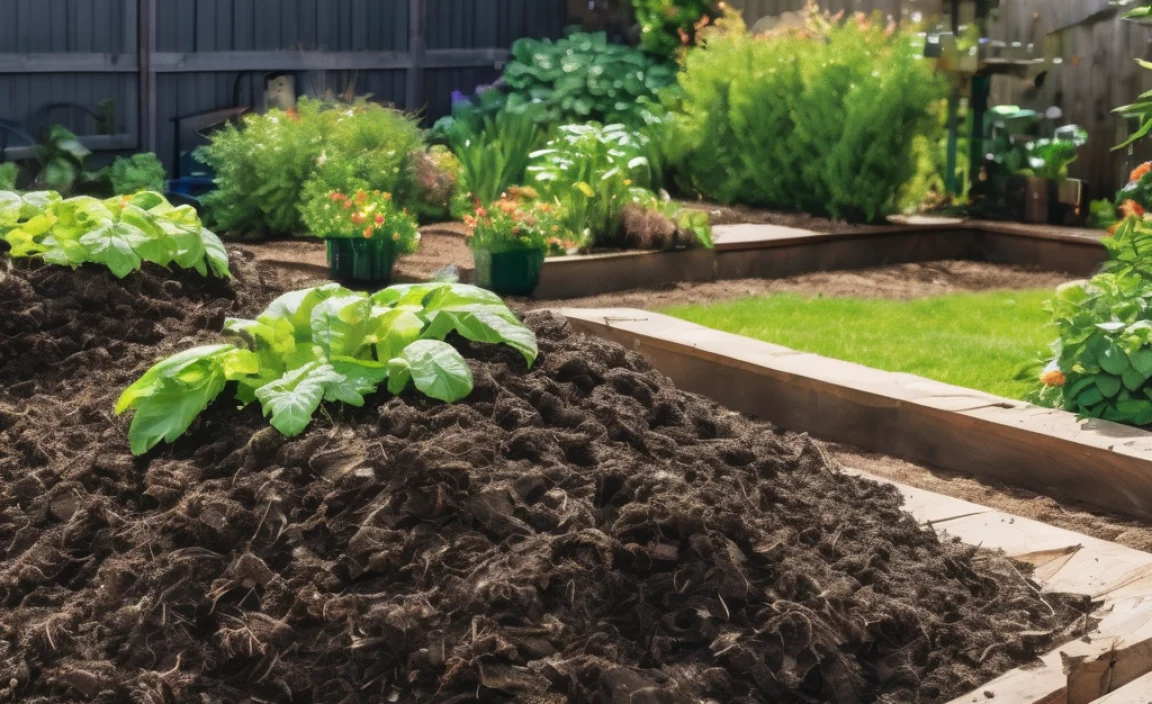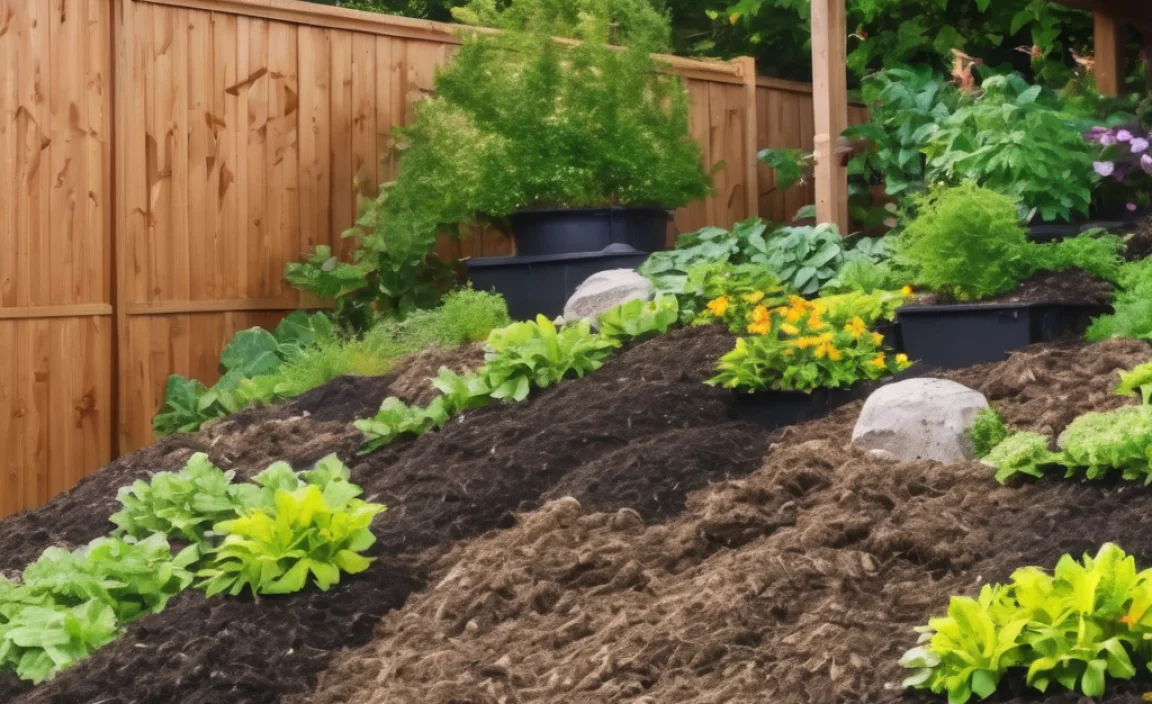Have you ever wondered how to turn kitchen scraps into garden gold? A compost pile is a magical way to do just that! Many people don’t realize how easy it is to make one. It’s like having a secret garden helper. By learning a few compost pile tips, you can start helping the environment and your plants. Let’s dive into the world of compost to discover how it works!
Key Takeaways
- Compost helps plants grow strong and healthy.
- Turn your compost pile to mix and aerate.
- Add a mix of “greens” and “browns” to compost.
- Keep the compost moist, but not soggy.
- Follow simple compost pile tips for faster results.
Compost Pile Tips For Beginners

Starting a compost pile can seem tricky, but it’s really simple. You just need the right materials and steps. Begin by picking a spot in your yard. Make sure it’s easy to reach. Your compost pile needs a mix of green and brown materials. Green materials are things like fruit scraps and grass clippings. Browns are items such as dried leaves and paper. Keep these things handy.
- Choose a shady spot for your pile.
- Use a mix of greens and browns.
- Turn your pile every now and then.
- Keep it moist, not wet.
- Avoid adding meat or dairy.
- Use a pitchfork or shovel to turn it.
- Start with a small pile if you’re new.
Turning the pile is important. It mixes the ingredients and helps air reach the microbes. These tiny helpers break down the materials into compost. Think of it like baking a cake. You need to mix things up to get the right result. Your compost will be ready when it smells earthy and looks like dark soil.
Fun Fact or Stats : A well-maintained compost pile can heat up to 160°F!
Why Is Compost Important?
Compost is nature’s way of recycling. Have you seen fallen leaves on the ground? They break down over time, turning into rich soil. This is what composting does, but faster! Compost adds nutrients to soil, helping plants grow stronger. It’s like giving your garden a vitamin boost. Plus, it reduces waste. Less trash goes to landfills, which is great for the planet.
How To Start Your Own Compost Pile
Starting a compost pile is like starting a new hobby. Imagine turning kitchen waste into something useful. Begin by gathering materials. Find a spot in your backyard. Lay down a layer of sticks or straw. This helps with air circulation. Add a mix of green and brown materials. Keep adding to it each week. Soon, you’ll have a thriving compost pile.
What To Put In Your Compost Pile
Have you ever seen a banana peel in the trash? It belongs in the compost! Compost needs a balance of materials. Greens include veggie scraps and coffee grounds. Browns are dry leaves and newspaper. Avoid adding meat or dairy. They can attract pests and smell bad. Keep a small bin in your kitchen. Fill it with scraps, then add them to your pile.
Finding The Right Balance In Compost

Balance is key to a successful compost pile. Think of it like a recipe. You need the right ingredients in the right amounts. Greens provide nitrogen, which fuels the composting process. Browns add carbon, which gives structure. Too much of one can slow things down. A good rule is two parts brown to one part green. This creates an effective pile.
- Two parts brown to one part green.
- Adjust as needed for your climate.
- Mix materials thoroughly.
- Add water if it feels dry.
- Monitor the temperature regularly.
- Avoid adding diseased plants.
- Cover the pile to retain moisture.
Testing the balance is easy. Grab a handful of compost. It should feel moist, like a damp sponge. If it’s too dry, add water. If it’s too wet, add more browns. With patience, you’ll find the perfect mix. This balance helps break down materials quickly and efficiently.
Fun Fact or Stats : Compost piles can reduce household waste by 30%!
How To Troubleshoot Compost Problems
What if your compost smells bad? Don’t worry! Bad smells mean something’s off. Maybe it’s too wet or needs more air. Start by turning the pile to add air. Check the moisture level. If it’s soggy, mix in browns. Smells often come from too many greens. Adjust the mix, and the smell should improve.
Keeping Pests Away From Your Compost
No one wants pests in their compost. They can ruin all your hard work. Keep them away by not adding meat or dairy. Use a lid or cover over your pile. This keeps animals from digging in. Turn the compost often. This makes it less inviting to pests. If you notice flies, cover fresh greens with browns. This hides the smell and keeps them away.
How To Speed Up Composting
Want compost faster? Try chopping materials before adding them. Smaller pieces break down quicker. Turn the pile every few weeks. This adds air and speeds up the process. Keep the pile moist but not soaked. A pitchfork or shovel works best for turning. With these tips, you’ll have compost in just a few months!
Compost Pile Tips For Season Changes

Composting changes with the seasons. In winter, things slow down. The cold can freeze the pile. In summer, heat speeds it up. To keep things moving, adjust your practices. In winter, insulate the pile with straw or leaves. In summer, water it more often. This handles the heat and keeps it from drying out.
- Insulate the pile in colder months.
- Water more in the summer heat.
- Turn the pile regularly.
- Balance greens and browns.
- Watch for temperature changes.
- Adjust the mix for each season.
- Cover the pile during heavy rain.
Seasonal changes affect composting efficiency. In spring, nature wakes up. This can speed the process. Be ready to add more browns to balance the mix. Fall is great for gathering leaves. These are excellent browns for the pile. Adjust your practices to match the seasons, and you’ll have compost year-round.
Fun Fact or Stats : Compost temperature drops below 50°F in winter!
Compost In The Winter
Did you think composting stops in winter? Think again! It just slows down. The cold slows the microbes. But you can keep composting. Insulate the pile with extra leaves. Cover it with a tarp. This traps heat inside. Keep adding scraps. In spring, the pile will start moving again. You’ll have a head start for the new growing season.
Compost In The Summer
Summer heats up composting! The sun warms the pile, speeding up decomposition. But be careful. Too much heat can dry it out. Water the pile if it feels too dry. Turn it more often to keep things cool. Summer is a great time to boost your compost with extra greens. This will keep it active and productive.
Handling Rainy Days
Does rain affect your compost pile? Yes, it can! Too much rain makes it soggy. This slows down decomposition and attracts pests. During rainy times, cover your pile with a tarp. This keeps excess water out. If it gets too wet, mix in more browns. Keep an eye on it to ensure it stays healthy. Your compost will thank you!
Table: Composting Seasons

| Season | Temperature | Activity Level | Adjustment Tips |
|---|---|---|---|
| Spring | Moderate | High | Add more browns |
| Summer | High | Very High | Water more often |
| Fall | Cooling | Moderate | Collect leaves |
| Winter | Low | Low | Insulate pile |
Conclusion
Composting is a fun and rewarding activity for everyone. By following these compost pile tips, you can create rich soil for your garden. Remember to balance greens and browns, turn the pile, and adjust for seasons. Soon, you’ll see the magic of composting in action. Your garden will love the nutrient boost!
FAQs
Question: What materials should I avoid in my compost pile?
Answer: Avoid adding meat, dairy, and oily foods to your compost pile. These items can attract pests and create bad smells. Stick to plant-based scraps like fruit peels, vegetable bits, and coffee grounds for the best results. Following these compost pile tips ensures a healthy compost environment.
Question: How often should I turn my compost pile?
Answer: Turn your compost pile every two to three weeks. This helps mix the materials and adds air, speeding up decomposition. Use a pitchfork or shovel for easy turning. Maintaining a regular schedule ensures your compost stays active and productive.
Question: How do I know when my compost is ready?
Answer: Your compost is ready when it looks dark and crumbly. It should smell like fresh earth. This process usually takes three to six months, depending on conditions. Following compost pile tips helps speed up the process, so keep your pile active!
Question: What is the best spot for a compost pile?
Answer: Choose a shady spot that is easy to access. The shade keeps the pile from drying out too quickly. Make sure it’s close to a water source for easy maintenance. Following these compost pile tips ensures a thriving compost pile.
Question: Can I compost during winter?
Answer: Yes, you can compost during winter, but it slows down. Insulate your pile with straw or leaves to trap heat. Cover it with a tarp to protect against snow. Keep adding scraps to prepare for a spring compost boost!
Question: How do I speed up the composting process?
Answer: To speed up composting, chop materials into smaller pieces before adding. Turn the pile every two weeks to add air. Keep it moist, like a damp sponge. Following these compost pile tips helps create rich compost faster.
.lwrp.link-whisper-related-posts{
margin-top: 40px;
margin-bottom: 30px;
}
.lwrp .lwrp-title{
}.lwrp .lwrp-description{
}
.lwrp .lwrp-list-container{
}
.lwrp .lwrp-list-multi-container{
display: flex;
}
.lwrp .lwrp-list-double{
width: 48%;
}
.lwrp .lwrp-list-triple{
width: 32%;
}
.lwrp .lwrp-list-row-container{
display: flex;
justify-content: space-between;
}
.lwrp .lwrp-list-row-container .lwrp-list-item{
width: calc(25% – 20px);
}
.lwrp .lwrp-list-item:not(.lwrp-no-posts-message-item){
max-width: 150px;
}
.lwrp .lwrp-list-item img{
max-width: 100%;
height: auto;
object-fit: cover;
aspect-ratio: 1 / 1;
}
.lwrp .lwrp-list-item.lwrp-empty-list-item{
background: initial !important;
}
.lwrp .lwrp-list-item .lwrp-list-link .lwrp-list-link-title-text,
.lwrp .lwrp-list-item .lwrp-list-no-posts-message{
}@media screen and (max-width: 480px) {
.lwrp.link-whisper-related-posts{
}
.lwrp .lwrp-title{
}.lwrp .lwrp-description{
}
.lwrp .lwrp-list-multi-container{
flex-direction: column;
}
.lwrp .lwrp-list-multi-container ul.lwrp-list{
margin-top: 0px;
margin-bottom: 0px;
padding-top: 0px;
padding-bottom: 0px;
}
.lwrp .lwrp-list-double,
.lwrp .lwrp-list-triple{
width: 100%;
}
.lwrp .lwrp-list-row-container{
justify-content: initial;
flex-direction: column;
}
.lwrp .lwrp-list-row-container .lwrp-list-item{
width: 100%;
}
.lwrp .lwrp-list-item:not(.lwrp-no-posts-message-item){
max-width: initial;
}
.lwrp .lwrp-list-item .lwrp-list-link .lwrp-list-link-title-text,
.lwrp .lwrp-list-item .lwrp-list-no-posts-message{
};
}


